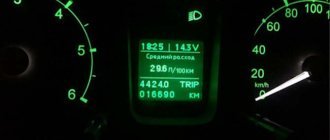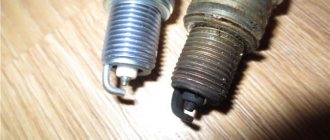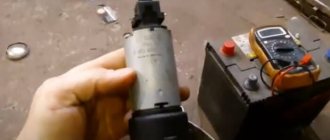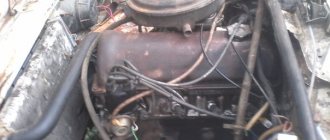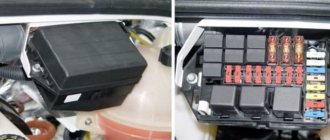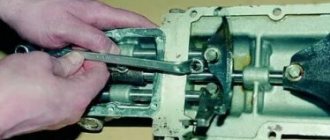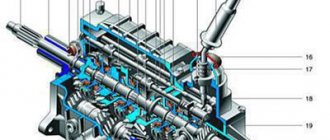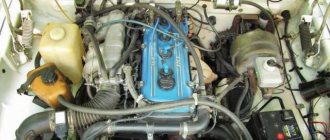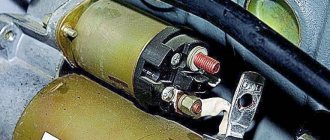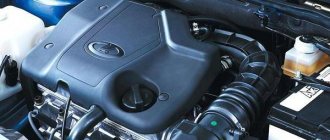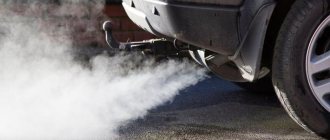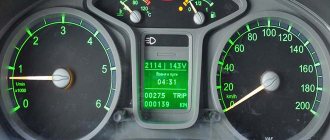Gazelle Next is equipped with diesel, gasoline and gas engines.
Regardless of the type of power plant, during operation, the car owner may be faced with a situation where his car does not start.
If the engine does not start, it is important for the driver not to panic, but to take troubleshooting measures.
GAZelle starter: device, malfunctions, repairs
Sooner or later, any owner of a Gazelle Business or Next with a Cummins diesel engine may encounter a problem - the car will not start.
You need to go on a flight, but the car is parked and it’s not clear what happened, because everything seemed to be fine. What to do in this case? Let's try to understand the main reasons for this phenomenon and what needs to be done to eliminate them.
Let's say right away that we will not consider such obvious reasons as lack of fuel in the tank and a dead battery. We really hope that your driving experience is enough to independently identify and eliminate these causes.
If you require original spare parts for the Cummins ISF 2.8 engine, you can always purchase them in our online store.
Call and get a free consultation with a specialist right now!
8-800-100-24-93
free call from mobile
Diesel engines of trucks and tractors. Spare parts, adjustments and repairs.
Injection pump of the fuel system of the Gazelle Cummins ISF 2.8 engine
The Cummins ISF 2.8 diesel engine of the Gazelle Business uses a fuel system with a common high-pressure fuel line and an electronic control system.
The high pressure fuel line system consists of 4 main elements: the gear fuel pump, the high pressure pump, the common high pressure fuel line and the injectors.
The high pressure pump supplies fuel to the common high pressure fuel line regardless of engine speed.
Fuel under high pressure accumulates in this fuel line, from where it is constantly supplied to the injectors.
The ECM regulates fuel supply and injection timing by turning on the injectors.
A water separating fuel filter must be installed on the fuel intake side. It is located outside the engine and contains a manual booster pump.
Fig.29. Cummins ISF 2.8 diesel fuel system diagram
1 - Fuel supply from the tank, 2 - Fuel filter, 3 - Fuel water separator drain pipe, 4 - Booster pump, 5 - Fuel supply to the fuel pump, 6 - High pressure fuel pump, 7 - Fuel supply to the common high pressure fuel line, 8 — Common high pressure fuel line, 9 — Fuel supply to the injectors, 10 — Injector, 11 — Drain fuel from the injectors, 12 — High pressure reducing valve, 13 — Drain pipe of the high pressure reducing valve, 14 — Drain fuel line, 15 — Drain fuel into tank
The gear fuel pump of the Cummins ISF 2.8 diesel engine of the Gazelle Business car creates a pressure of about 303 - 1303 kPa, due to which the fuel is cleaned in a filter installed on the engine or outside it before entering the injection pump.
In this pump, the fuel pressure increases to a level of 250 - 1600 bar in three radial discharge chambers.
The electronic fuel control system actuator valve, installed at the inlet to these chambers, regulates the amount of fuel entering them.
To do this, it uses signals from the ECM, which maintains the pressure in the common high-pressure fuel line at the required level.
Fuel that does not enter the plenums exits through the cascade bypass valve.
It directs part of the fuel under pressure into the lubrication system channels of the Cummins ISF 2.8 diesel high-pressure pump and then drains the fuel into a tank, which accumulates fuel and distributes it between the fuel lines of individual injectors.
It contains a sensor that monitors the pressure created in it by the high-pressure pump. The signal from this sensor is used by the ECM to control the flow of the high pressure fuel pump.
In addition, there is a pressure reducing valve in the common fuel line.
It works as a safety valve, releasing excess pressure if the pressure in the fuel line exceeds a set level.
Intake air heating coil
For the fuel mixture to ignite, it must be at a certain temperature. And in order for the mixture to reach the desired temperature, Cummins ISF 2.8 engines have an element called an intake air heating spiral (candle).
This engine element starts working at low temperatures. It is located in the engine intake manifold and starts working after turning the ignition key. In principle, in the summer, when it’s warm outside, you can do without this detail. But on frosty days, starting the engine with the intake air heater not working will be very problematic.
Therefore, in the cold season, the first thing you need to do is check whether the intake air heating coil is working. This is easy to do - when the spiral is running, the intake manifold should be warm.
It is necessary to inspect the contacts of the spiral and the wires going to them. It often happens that the wires simply break. But sometimes it happens that the spiral itself fails. In this case, only replacing it will help.
Why the starter does not turn or turns slowly, common causes and solutions
Everything applies to Gazelle cars and not only... “Why doesn’t the starter turn”, “Something clicks under the hood and there’s silence” or “There’s a click and everything goes out” - such questions can often be seen in discussions on car forums. These are the most common signs of problems with the wiring, solenoid relay, bushings, or the starter motor itself. Let's look at a few of the main and most common causes of starter failure. We will assume that the engine itself, the crown (its teeth) are in good condition, and the battery, especially in the cold season, is charged and does not lose charge due to a consumer unknown to the owner.
And so, when you turn the key, nothing happens or clicks are heard in the engine compartment (one or a series of them). In most cases, the problem lies in poor contacts. Unfortunately, there are not one or two contacts that are important for the operation of the starter. If your car is not new, the problem may be hidden in the power wires, ground - their terminals. It is important that there is reliable contact on ALL wire terminals. These wires can be perfectly pinged by the tester, but when the starting current runs through them, they simply will not pass the power that is needed to start the starter.
The stranded power wire is simply crimped with a terminal and is not protected from external influences. Over time, the contact deteriorates at the crimping site - dirt and water from the road get in and corrosion occurs. Often, with such wires, the starter does not turn the first time in damp weather, after rain. To quickly restore contact, sometimes you have to remove the terminal and tap the wire at the crimp point on a hard surface. The best option for solving problems with wires is, of course, replacing them with new ones; or disassembling terminals, stripping, tinning, re-crimping and soldering. Moreover, the places where the terminals are pressed through washers with nuts (the weight of the cabin, the engine, the power plus on the retractor) are most often deformed and also have traces of corrosion - this is also an obstacle to good contact. It is advisable to straighten them, clean them and re-tin them. For me personally, the option of tinning and soldering gave the desired result. Another contact that can prevent the starter from starting is the contacts on the battery itself. They also need to be kept clean and dry. Therefore, many, having secured the wire to the battery terminal, cover this place with thick lubricant on top.
If you have sorted out the power and control relays and wires, then all that remains are the contacts in the solenoid relay itself (nickels) - copper plates in the relay body through which a large current flows. These contacts can burn over time, but this happens very rarely, and to check or clean the contacts you will need to unsolder the two winding terminals and remove the relay cover. More often than not, the relay itself—the winding—fails and burns out. In this case, only replacement.
When the starter turns idle, the problem can be in several places:
- insufficient travel or wear of the fork moving the bendix;
- the bendix itself is not working properly - it scrolls;
- for a gear starter with plastic elements in the planetary mechanism - wear of the teeth.
In the last two cases, a squealing or crunching sound will be heard at a high speed of rotation of the starter shaft, without transmitting rotation to the flywheel.
Tips for motorists
On Gazelle cars, an ST230-B4 starter with a power of 1.5 kW is installed, and with its help, the driver can start the engine of his Gazelle more than once a day. The driver, using the ignition key, activates the electrical starter circuit, which includes: a starter relay, a traction relay, a DC electric motor and a battery.
Malfunctions leading to starter failure are divided into two groups: electrical and mechanical. Electrical faults include :
- failure of the starter relay to operate, in this case the traction relay is de-energized and its core will remain motionless, which means that its contacts will not be able to close;
- burning of contacts in the traction relay will lead to the fact that voltage from the battery will not be supplied to the starter brushes;
- wear of the starter commutator brushes, then the armature winding will remain without voltage and it will not rotate;
- burning and wear of the commutator plates will also leave the armature winding without voltage;
Mechanical faults to starter failure include:
- wear of the drive gear teeth and flywheel ring teeth, in which case they cannot engage with each other;
- slipping of the freewheel leads to the fact that the starter armature will rotate, but its drive gear will remain stationary, and therefore the engine crankshaft will not rotate;
- It is also possible that the core of the traction relay may become jammed, as a result of which its contacts will not be able to close and the commutator brushes will remain without voltage;
- wear of the spline connection, overrunning clutch, with the armature shaft can lead to jamming of the drive mechanism;
- The bushings in which the armature rotates also wear out, resulting in backlash that can lead to the armature getting caught on the starter stator.
What to do if the Gazelle stalls while driving?
If the Gazelle stalls while driving, then the first thing you need to do is look at the fuel, or rather its supply.
It is necessary to inspect the engine compartment for fuel leaks. It happens that due to vibrations, the fixing bracket unscrews and the tube from the injection pump to the ramp bursts.
Even a small crack in the tube will be enough for the pressure in the system to drop and the engine to stop working. This phenomenon is usually accompanied by a yellow check.
If everything is in order with the tube from the injection pump to the ramp, we recommend continuing to inspect the fuel system and pay attention to the fuel filter housing. Sometimes it happens that its top cover fails and air begins to leak through it.
Why doesn't the car start?
If your car does not start, then most likely there is no gas in the tank. However, if you turn the ignition key and nothing happens, then there is a 99% chance that the battery is dead. There is a 1% chance of an open circuit.
To begin with, we recommend looking under the hood and making sure that both wires are connected to the battery terminals and there are no visible wire breaks. If everything is in order with the wires, then check the voltage at the terminals with a regular tester; it should be at least 10 volts.
Although at least electrical appliances can operate at a lower voltage, the starter will no longer be able to turn.
If the battery is already old, then you can buy batteries for trucks in the nearest store or online, but first you need to decide on the following characteristics:
For those who don’t know, we hasten to inform you that you should always remember about the battery. After all, it is he who is responsible for starting the engine, and also ensures the operation of all electrical circuits of the car when the engine is stopped. For example, side lights when parking, or hazard warning lights. Starter batteries are divided into three main types:
- Serviced - they are becoming less and less common on sale, since the demand for them is low. These batteries have an ebonite casing filled with black mastic to the very top, so they are easy to recognize. Their disadvantage is that they constantly require attention; you often need to add electrolyte or water.
- Low-maintenance batteries are extremely popular. They also do not have any serious operating restrictions, so they are easy and convenient to use. This type of battery is very widely represented on the market. Their price ranges from very affordable to expensive models suitable for modern brands of cars from the world's leading companies.
- Maintenance-free batteries are most popular among equipment owners. This is easily explained by the fact that they are manufactured using the most modern technologies. Their design is completely sealed, and silver is added to the hybrid plate type. Their level of convenience is very high, as is their operational reliability. That is why it is worth paying a considerable price for such a battery.
Recommendations
Comments 26
what to do, the ignition does not work, the snout clicks and the starter does not crank
I bought a power fuse block a long time ago, but it turned out to be the latest standard with 6 mm studs. And I have smaller terminals!
I need to work hard on the wiring, but it’s still cold!))
Now! With the indicator I touch the chip of the “+” wire leading from the fuse block to the PC, it doesn’t glow, I touched the insulated terminal “it’s on”, I jumped into the cabin, I turn the key, the starter doesn’t work.
I threw a parallel wire “+” from the block and secured it to the PC, everything works!
Thank you all so much for your advice!
Does the relay click from the key? if yes, the control circuit is working.
Assuming that the starter itself is working, since it comes to life when it is closed, the power circuit remains: a wire from the main fuse block to the relay and from the relay to the starter. Well, and of course, the largest and thickest wire from the + battery.
check for snot and oxidation of compounds. and that's all.
does it rotate straight, but the retractor does not work, or does it click straight?
I have a small wire (which I temporarily ran in parallel) leading from the PC (in parallel) to the lilac wire, I connect it to the “+” terminal on the starter and the starter turns!
Well, the retractor itself works or clicks. The nickels may just burn out, or the holding winding may burn out.
Yes, the retractor works!
and does the engine turn normally? then the lock, the starter relay, and if there is a relay in the gap from the signaling system, then look at that too
In short, when I bought the car, I started to wash everything and found that a wire was laid from the starter relay (it was just dangling), I threw it away, four months later a friend came up, it said there is a SHABASH), give the car, I say take it naturally. I left for work, he calls after 2 hours, it says the starter is not working, I arrived, it says let’s change it, and there’s a snowstorm outside, we call another friend and say melt the potbelly stove in the garage, we’re on our way, we got stuck, we transferred the snow with the volume of GAZ -53)), they changed it starter, but it doesn’t work, I bought a new starter relay, “0” again, that’s where I remembered about this wire. In the end, they set the starter to “RETAKES ITSELF”, the battery is brand new and it barely turns!
I came home tired, my father said “You have no mass”, and this wire is “MASS”, in the end I didn’t figure out what the wire was. I installed an old starter and everything works!
This happened about 2 months ago! And now it refused again!
The ground on the retractor relay is short, it is screwed to the cabin, + goes from the fuse block through the relay to the retractor plug, control comes from the lock.
The engine should turn straight if you connect the plug on the retractor with a wire from the battery positive
if the engine does not turn, or poorly, then it is a thick mass on the body. if it is ordinary, then + nuts. If it clicks, it's the retaining winding. if it clicks and doesn’t turn, then nickels
To be honest! I didn’t realize it! + on PC comes from the lock? The weight is small on the body! (on a PC) How to check the ignition switch?
control + ground from the lock to the body and to the engine somewhere, it looks either like a healthy pigtail, or like a thick dark wire, check from the lock, there is either a pink or reddish narrow one, you will find it simply by holding the key in the starter position
mass RS there is a small narrow wiring
The weight on the engine is normal! Now I'm picking!)
does it rotate straight, but the retractor does not work, or does it click straight?
Damn, I have such a problem: it doesn’t turn the starter directly, just like with the key, it can’t turn it over, what’s the matter?
Source: www.drive2.com
Air leak
Very often, the cause of poor engine starting can be a banal air leak. From our experience, it most often occurs through the intake pipe in the tank or through a failed separator cover. To check for air leaks in the fuel system, it is necessary to replace the fuel pipe from the filter to the injection pump with a transparent hose.
Bubbles in the fuel will immediately indicate the presence of air leaks. As we have already said, it is necessary to check the separator cap and the intake pipe in the tank, as well as all connections of the fuel pipes.
The starter clicks but does not start the engine
Well, now we come to the most interesting part. Why can there be clicks when turning the key in the ignition, but the engine does not start ? In 60% of cases the problem is in the solenoid relay. However, there may be problems with the wires, which should be checked immediately:
- Low battery . Many people confuse the clicking sounds of the starter with a discharged or failed battery (there will be a kind of crackling sound, but it will not be a one-time sound). There simply isn’t enough power to crank the engine, you just need to recharge or replace the battery.
- Poor contact at the positive terminal . The very first thing we do is look at the terminals on the battery; if there are oxides, then they need to be removed. The thing is that the positive wire goes to exactly one contact of this retractor relay. If the contact is bad, then the system will not work well (and it’s not just the clicks).
- Poor contact at the relay itself. The wire from the battery can also oxidize at the starter itself. This often happens from high mileage. You need to unscrew both power wires (usually they go to the relay) and clean them well. Perhaps the reason will disappear
- Poor ground contact. The negative terminal is attached to ground (often to the car body or engine), if there are oxides here again, either from the terminal side or from the contact point, then they also need to be removed.
- Solenoid relay. This is a common breakdown (especially on old VAZs) - when you turn the key, you hear clicks, but nothing happens. However, if you turn the key several times, for example two or three times, the engine may start on the fourth time. THIS IS DEFINITELY A RELAY; it needs to be changed or cleaned.
- The teeth of either the BENDIX or the flywheel crown have broken . Of course, then not only clicks will be heard, but also a strong crunching sound from under the hood. This happened to me only once in practice.
In my practice, when I had front-wheel drive VAZs, first of all we clean the terminals and contacts of the starter, and then remove the solenoid relay and look at it. It may be better to replace it right away and not have to suffer.
Battery problems
If the Gazelle does not start, then you should start searching for the impossibility of starting the engine with the battery. If it is insufficiently charged, the starter does not have enough energy to turn the crankshaft. In this case, a significant drop in the on-board network voltage occurs. The traction relay starts to click, but the engine cannot start.
ATTENTION! A completely simple way to reduce fuel consumption has been found! Don't believe me? An auto mechanic with 15 years of experience also didn’t believe it until he tried it. And now he saves 35,000 rubles a year on gasoline! Read more"
The situation with starting the engine with a discharged or old battery is aggravated in cold weather. There are two reasons for this:
- engine oil thickens in the cold and it becomes more difficult for the starter to crank the crankshaft, which causes increased starting current and greater battery energy consumption;
- When it's cold, the chemical reactions of the battery slow down and the battery becomes able to deliver less charge.
In winter, both of the above reasons overlap each other. Starting becomes especially difficult when cold. Under unfavorable conditions, the car may completely refuse to start.
With a discharged battery, many car owners start their Gazelle only with a pusher, but there are other ways, the main ones being:
- start using ROM;
- “lighting up” from another vehicle;
- charging the original battery with a nominal or increased current and then starting the power unit.
A situation with a discharged battery does not require special attention from the car owner if it occurs only once. It is enough to recharge the battery and you can continue to operate the machine as before. If the battery dies often, then it is necessary to diagnose it. Based on its results, a decision is made on the method and feasibility of restoration work. In some cases, it is more rational to purchase a new battery.
If the battery shows full serviceability, but dies in a short period of time, then the on-board network must be checked. It may contain short circuits and high leakage currents. If they are identified, you should not delay troubleshooting. Prompt resolution of problems will eliminate the risk of a car fire.
The presence of through cracks and other similar defects leads to the loss of part of the electrolyte. The battery's ability to deliver starting current and energy is significantly reduced. To diagnose the problem, just carefully inspect the case. If any damage is detected, the car owner is faced with a choice between carrying out repairs or purchasing a new power source.
How to check injectors on a Gazelle with a Cummins ISF 2.8 engine yourself
In order to independently check whether the injectors are draining into the return line, you need to use ordinary medical syringes. For more information about this, watch Denis Gorban’s video
If the injectors are delivering too much fuel to the cylinders, the fuel mixture will not be correct and the fuel will not burn completely, causing you to see thick black smoke coming from the exhaust.
Thick black smoke may also be due to a clogged air filter, but if the cause lies in the injectors, we recommend that you stop using the vehicle immediately. Otherwise, due to too high a temperature in the combustion chamber, the engine may overheat or the piston may melt, which in turn will lead to expensive overhauls.
Special cases
In addition to all of the above, other adventures happen with the Gazelle 405. Many drivers do not notice how the chain on the engine jumps. Accordingly, the engine refuses to come to life until the chain is in its place.
Your task is simply to open the hood and check if the chain is in order
, if not, then put it in its place. This procedure will take you 10 minutes at best, but you will be able to start your car. Otherwise, the Gazelle 405 injector does not start due to other problems.
It is quite difficult to answer this question, so we have simply listed for you several of the most common breakdown options. You can get an accurate answer only after a thorough diagnosis. It is at this stage that you can find out the reason why the car refuses to start. Therefore, do not rack your brains and better contact a car service center.
AUTO -GAS 3302 INJECTOR 405 stalls diagnostic codes: 13 - low signal level of the air flow sensor 22 - high signal level of the coolant temperature sensor; 53 - malfunction of the angular synchronization sensor; 135 - load break in injector 2 circuit.
The following happens: Replaced the air filter, idle speed sensor. I adjusted it a little on the spot, the engine was already hot! It seems to be going, but when picking up speed of about 50 km, you need to slow down, for example, before a traffic light - the RPMs begin to drop to almost 0, and it stalls! Then I started it, drove, the situation was the same again, but before reaching 0 I accelerated in neutral (while I was driving), the gazelle picked up the speed and held it, and in 1st and 2nd gears I drove normally and braked and the acceleration did not stall, but above 2- 1st gear and subsequent braking tries to stall if I even almost give in to the throttle!! ! The next day I start it and it starts, but immediately stalls! Only again, if at the moment of starting I pick up the throttle and keep it at at least 1.5 rpm, it works. I quit the gas and it stalls! What could be the reason, I understand that it’s a bag, but still, who might have had such a problem, please tell me! There is gas equipment, but it behaves the same on both gasoline and gas (it seems better on gas - I adjusted it yesterday), on-board computer. It doesn't behave predictably at all!
Faulty injection pump
The reason that the car does not start may be a breakdown of the high pressure fuel pump. The injection pump fails due to the following reasons:
- poor quality fuel;
- water and dirt in fuel;
- long-term operation of the car with air leaks.
The first two reasons for fuel pump failure are obvious. Why does the fuel injection pump break down due to air leaks? The fact is that modern common rail system pumps do not have a separate lubrication system and are lubricated with diesel fuel.
And when there is air in the fuel, the injection pump begins to run “dry”, which is why the friction between the pump elements increases significantly and over time it begins to drive metal shavings.
These metal shavings can cause fuel injectors to fail over time. If you need to turn the starter for a long time to start the engine and if the engine runs unevenly and with vibrations, then most likely this indicates an air leak.
In order not to destroy the fuel system and avoid expensive repairs, we recommend eliminating this air leak as soon as possible.
What is a starter and how does it work?
Let's briefly touch on the basics.
So, at the base of the starter there is a constant current electric motor. At the front end of its shaft there is a sliding coupling and a gear, which at the moment of starting meshes with the teeth of the motor flywheel. The movement of the clutch is ensured by a retractor relay located on the starter housing. At the moment of start-up, the relay rod {moves} and pulls the fork, which pushes the clutch and gear into the position of engagement with the flywheel.
The traction relay coil has two windings.
- Retracting. Connects when the key is turned to the “start” position. It ensures movement of the relay rod. After the first winding is triggered, the rod {moves} and moves the contact “penny”, closing with it the contacts that include the starter motor and the second, holding winding.
- Holding. It is needed to keep the rod retracted until the key is in the “start” position.
Accordingly, all malfunctions come down to either dilemmas with the retractor, or with the electric motor itself, or with the clutch.
Usually, the starter refuses to start the car at the most inopportune moment and completely unexpectedly. In other words, everything was fine yesterday, but now we turn the key to the “start” position, but it doesn’t turn... either it turns but somehow not the way it should, or it makes strange sounds. In any case, there is no need to expect a miracle; it will not go away on its own. Let's try to find and fix the problem.
Causes of malfunction
If the starter turns poorly when the battery is charged, then the breakdown, in most cases, is in the engine starting device.
The reason for the low engine speed, in this case, may be:
Before you begin to identify the above reasons, you should make sure that the battery produces sufficient current to start the engine. To do this, you can use a load fork. If the battery is serviceable, it is necessary to measure the density of the electrolyte.
Wiring faults
The starter of an internal combustion engine is the most energy-intensive piece of electrical equipment in a car, so poor-quality fastening of wires and terminals can reduce the efficiency of this device.
The current strength that occurs when the starter is turned on is so high that an electric arc can form in wires that are not well attached. Part of the energy will be spent on maintaining this effect, as a result of which the starter will rotate very slowly.
In addition to insufficient current in the circuit, an electric arc can lead to a fire, so if the battery does not turn the starter well, you should first inspect the battery connection terminals, and also check the quality of the connection of the positive wire, which is connected from the “+” battery to the solenoid relay.
You should also check the cable that connects the engine housing to the car body; there may also not be good enough contact in this place.
In addition to electrical leakage and loose nuts and bolts, the starter may lack electrical power due to oxidation of the battery terminals. In this case, a layer is formed of a substance that poorly conducts electric current, which is the reason for the deterioration of the starter’s performance.
This problem can be easily solved if you use a soda solution to remove the resulting oxidation layer:
- To prepare the solution, use ordinary soda and warm water in a ratio of 1 to 10.
- You can use a rag to clean the terminals, but the most suitable tool for this job is an old toothbrush.
Defective solenoid relay
A very common breakdown that can cause poor performance of the car’s starting mechanism.
If a short circuit occurs in the electromagnet winding, then this part will need to be completely replaced, but in most cases the reason for the unsatisfactory operation of the solenoid relay is a malfunction resulting from burning of the relay contacts.
In order to restore the functionality of the device, it is necessary to remove the solenoid relay from the starter housing and remove the ebonite cover to which the wires are connected.
Inside the device, there will be a copper plate that closes the relay contacts. It is this part that is most damaged. The surface of the plate that comes into contact with the contacts must be cleaned of irregularities that arise due to elevated temperatures during contact closure. To do this, you should use a velvet file, but remove the metal very carefully so that the plate does not become too thin, otherwise there will not be good contact between the electrical conductors.
The contacts located on the ebonite cover of the solenoid relay also need to be cleaned. To carry out this operation, you need to unscrew the bolts to which the wires are connected and clean them on the side where they come into contact with the contact plate. The surface of the bolts is cleaned with a file. It is necessary to remove a minimum amount of metal so that the contacts are in sufficient contact with the contact plate of the electromagnet.
When cleaning of the contacts is completed, assembly and installation of the solenoid relay is carried out in the reverse order. The bolts of the retractor relay must be well fixed in the ebonite housing, but the threaded connection should not be twisted, otherwise the fragile material of the cover of this device may be damaged.
Let's check the retractor
If voltage comes to the control contact of the retractor relay, the ground is not broken, but the starter refuses to cooperate with you and does not turn, do the following.
- Be sure to remove the car from gear and put the handbrake on;
- Turn the key to the “ignition” position;
- We take a 17mm wrench and use it to bridge the power terminals of the retractor.
If the starter spins vigorously, then our problem is in the solenoid relay itself. The easiest way would be to simply replace it with a new one, but you can try to repair it.
We remove the starter and unscrew 3 screws (2 screws for ZMZ 406) securing the retractor. We unscrew the screws securing the contact group and examine the condition of the contact “penny” and the contact pads of the bolts. Most likely, we will find severe burning on them. We clean the contacts and make their surface absolutely smooth and flat. We carry out a similar operation with a nickel. A badly eaten penny, you can simply turn it over if this has not been done before.
We will also use a tester to check whether the relay windings are shorted to the housing and whether there are any breaks in them. If everything is normal, put everything back together and try to start.
Low compression
If the engine throws oil out through the breather or consumes it in large quantities, and the operation of the car is accompanied by bluish smoke with a characteristic burning smell, then most likely the internal combustion engine has problems with the piston group and in particular with the piston rings.
When the piston group wears out in the cylinders, compression drops and therefore, again, the pressure in the cylinders necessary to start the engine will not be created. In such cases, only a major overhaul of the internal combustion engine will save you.
